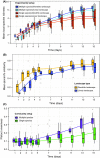Active colonization dynamics and diversity patterns are influenced by dendritic network connectivity and species interactions
- PMID: 24834323
- PMCID: PMC4020686
- DOI: 10.1002/ece3.1020
Active colonization dynamics and diversity patterns are influenced by dendritic network connectivity and species interactions
Abstract
Habitat network connectivity influences colonization dynamics, species invasions, and biodiversity patterns. Recent theoretical work suggests dendritic networks, such as those found in rivers, alter expectations regarding colonization and dispersal dynamics compared with other network types. As many native and non-native species are spreading along river networks, this may have important ecological implications. However, experimental studies testing the effects of network structure on colonization and diversity patterns are scarce. Up to now, experimental studies have only considered networks where sites are connected with small corridors, or dispersal was experimentally controlled, which eliminates possible effects of species interactions on colonization dynamics. Here, we tested the effect of network connectivity and species interactions on colonization dynamics using continuous linear and dendritic (i.e., river-like) networks, which allow for active dispersal. We used a set of six protist species and one rotifer species in linear and dendritic microcosm networks. At the start of the experiment, we introduced species, either singularly or as a community within the networks. Species subsequently actively colonized the networks. We periodically measured densities of species throughout the networks over 2 weeks to track community dynamics, colonization, and diversity patterns. We found that colonization of dendritic networks was faster compared with colonization of linear networks, which resulted in higher local mean species richness in dendritic networks. Initially, community similarity was also greater in dendritic networks compared with linear networks, but this effect vanished over time. The presence of species interactions increased community evenness over time, compared with extrapolations from single-species setups. Our experimental findings confirm previous theoretical work and show that network connectivity, species-specific dispersal ability, and species interactions greatly influence the dispersal and colonization of dendritic networks. We argue that these factors need to be considered in empirical studies, where effects of network connectivity on colonization patterns have been largely underestimated.
Keywords: Connectivity; dispersal; landscape structure; linear network; microcosm; protist; river-like.
Figures





References
-
- Altermatt F. Diversity in riverine metacommunities: a network perspective. Aquat. Ecol. 2013;47:365–377.
-
- Altermatt F, Holyoak M. Spatial clustering of habitat structure effects patterns of community composition and diversity. Ecology. 2012;93:1125–1133. - PubMed
-
- Altermatt F, Schreiber S, Holyoak M. Interactive effects of disturbance and dispersal directionality on species richness and composition in metacommunities. Ecology. 2011b;92:859–870. - PubMed
-
- Altermatt F, Seymour M, Martinez N. River network properties shape α-diversity and community similarity patterns of aquatic insect communities across major drainage basins. J. Biogeogr. 2013;40:2249–2260.
LinkOut - more resources
Full Text Sources
Other Literature Sources
Research Materials

